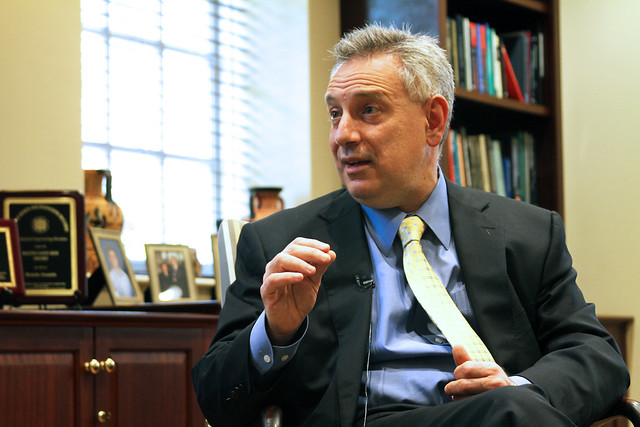The University announced Dennis Assanis as the sixth chancellor of UC Santa Barbara, who will assume the role on Sept. 1. Prior to this role, Assanis served as the president of the University of Delaware and had previously held administrative positions at Stony Brook University and the University of Michigan.

In 2022, UD introduced the First State Promise program which covers most costs for families that make $35,000 or less per year. Photo Courtesy of The Review
Assanis spent the first 18 years of his life living in Athens, Greece. His father, Nikolas Assanis, was a sea captain in the Merchant Marine, which sparked his interest in marine engineering. Since his father would spend the majority of his time on voyages, he would be gone from six months to a year and a half. He and his mother, Sandy Assanis, frequently visited his father, with one particular trip from Brazil to Romania standing out to him due to spending time on a 100,000 deadweight-ton vessel.
“Fascinated by the vast scale of these transportation/propulsion systems, I spent most my time in the engine compartment in the company of the ship’s engineers,” Assanis said in a 2018 interview. “That was where I developed my love for engineering.”
Following his father’s advice, Assanis received his bachelor’s degree in marine engineering from Newcastle University in England in 1980. From there on, he went on to receive three master’s degrees from Massachusetts Institute of Technology (MIT), including naval architecture and marine engineering in 1982, mechanical engineering in 1982 and management in 1986. He then went on to earn his doctorate in power and propulsion at MIT in 1985.
Soon after receiving his doctorate, Assanis went on to become an assistant professor of mechanical engineering at the University of Illinois in Urbana-Champaign from 1985 to 1990, and then an associate professor from 1990 to 1994. Afterward, he became a professor of mechanical engineering at the University of Michigan, where he served as director of several engineering programs and became a professor of applied physics in 2003, until his eventual departure in 2011.
After serving as a professor at the University of Michigan, he went on to become provost and senior vice president for academic affairs at Stony Brook University, where he oversaw the institution’s academic mission by supervising all academic units, supporting their services and coordinating all academic programs.
In November 2015, Assanis became the president of the University of Delaware (UD) by a unanimous vote by its Board of Trustees. Assanis went into the role with a desire to promote college affordability and diversify the UD campus.
As UD president, Assanis introduced initiatives in order to expand access to success for all students, with his main focus being on making college more affordable. During his term, UD had grown to place ninth in the nation for highest four-year graduation rates, along with undergraduate financial aid at UD increasing more than 95% since 2016, going from $94 million to $185 million. His tenure also saw a rise in applications to UD, with the University achieving a record number of applicants every year for the last six years.
In 2016, Assanis helped secure UD as the headquarters for the National Institute for Innovation in Manufacturing Biopharmaceuticals (NIIMBL), which helped advance United States leadership in the pharmaceutical industry, focusing on bringing safe drugs to market faster and increasing the biopharmaceutical unemployment rate.
Assanis also helped to launch the Delaware First campaign a year into his presidency, a fundraising initiative that has now garnered more than $1 billion toward scholarships and faculty research. The campaign created 482 scholarships, 189 programs and research funds that expanded research opportunities at UD.
He had also helped to establish UD’s Graduate College, which formalized the University’s graduate school experience with the creation of new interdisciplinary programs, offering over 60 doctoral and 145 master’s degree programs.
He also helped solidify the Forward and Forever plan, which represented a commitment to student success and transformation by investing in UD’s intellectual and physical capital, especially considering the COVID-19 pandemic’s impact on the University.
During the pandemic, UD faced a $250 million deficit in 2020, leading to layoffs and furloughs for all university staff, excluding professors. Later that year, the union representing the University’s professors, the American Association of University Professors (AAUP), agreed to refrain from negotiating pay increases for a year.
In 2021, Assanis established the President’s Student Advisory Council, which assembled student leaders across UD for discussion around pressing university issues. 14 undergraduate and four graduate students make up the council, and they regularly provide input on student-centered topics such as the University’s accomplishments and challenges. That same year, UD extended his contract as president until 2026.
In 2022, UD introduced the First State Promise program, which covers most costs for families that make $35,000 or less per year and covers tuition and mandatory fees for families that make $75,000 or less.
“I can’t tell you how passionate I am about really making the university accessible for every family under $75,000 so that we can increase the pipeline of students coming to the university every year,” Assanis said to the state finance committee when seeking program funding, according to the Newark Post.
The University has recently completed several new buildings, including the Wellbeing Center in 2022, the Center for Intercultural Engagement in 2023 and Building X in 2025.
Several faculty members including the president of the University’s AAUP chapter, questioned the University’s capital planning, or the construction of several new buildings, amidst the University’s ongoing budget deficit and lack of financial transparency.
“As far as capital planning, we actively assess needs and opportunities with a focus on the UD student and campus experience. Long-term capital planning has enabled us to keep an eye on the horizon of sources of funding — whether through philanthropy, grants, federal and state allocations, auxiliary revenue, allocated reserves or debt funding — as well as a disciplined process,” Assanis told Spotlight Delaware earlier this year.
In May, Assanis announced he was stepping down as president of UD at the end of the academic year, cutting his contract one year short. The UC Board of Regents approved his appointment as the next chancellor of UCSB in July, ending a nearly year-long search. Alongside the appointment, the Board of Regents approved a salary of $880,000 for Assanis — a $620,000 pay cut from his previous salary of $1.5 million at UD.
Assanis will formally assume the role on Sept. 1, and said he was “truly honored and thrilled” to serve as the next chancellor in his appointment’s announcement.
“I am particularly excited about UC Santa Barbara’s exceptional academic reputation, amazing students and boundless potential to be recognized among the top public universities, building on the celebrated achievements of its distinguished faculty and dedicated staff. Fostering a culture of innovation, academic excellence and student success has been my core focus as a public university leader,” Assanis said.





















Most, if not all, of this information in this article could have already been gleaned off the Internet. No new information is given which is strange because there are so many questions and it would be seriously odd if nobody at the Daily Nexus was given the opportunity to interview the incoming Chancellor. Doesn’t it just scream for an answer the question of why Chancellor Assanis accepted a huge pay cut to come to UCSB? Aren’t you in the least suspicious? Why would the University of Delaware be able to afford to pay Assanis $1.5 million per year while the… Read more »
What a piece of shit stop posting here and leave campus alone
I ❤️ Jack Dindia
All you need to know is that he’s got both ‘ass’ and ‘anus’ in his last name. Yup